The most widespread and abundant forest type in Australia is probably dry sclerophyll forest – the tallest trees are eucalypts and their relatives (Corymbia, Angophora, Lophostemon), and below them are sparse shrubs, heath and/or grasses and herbs. This forest type is common because it’s fire-tolerant, somewhat drought tolerant, and often grows on the crappy soils that no-one wants for anything else. Dry sclerophyll forest appears in some classic Australian paintings: think of Frederick McCubbin’s ‘Lost Child’ (1886) and Tom Robert’s ‘Bailed Up’ (1895-1927). Another depiction of dry sclerophyll forest – Hans Heysen’s ‘Sunshine and shadow’ (1904-5) – inspired the title of this post.
Unlike many northern hemisphere forests, these forests are full of light. Queensland, according to a well-known tourism campaign, is ‘beautiful one day, perfect the next’. The forests up here are often bathed in bright white-gold light, bleaching sunlit objects and casting deep shadows. They are hard to photograph, and hard to paint. I’m told not to take photos in ‘contrasty’ light – it’s much better to photograph in even light. For painting, it’s probably the same, although being self-taught, maybe I missed that lesson. But here are these ubiquitous, Australian, sunlit forests – I want to paint them full of sunshine and shadows, because that’s an important part of what they are.
Although there are a range of different dry sclerophyll forest types around Brisbane, I decided to focus on one of the most common: spotted gum / ironbark forest. To make preliminary sketches for my forest portrait, I went to Mt Coot-tha Forest, Bunyaville Forest Reserve and Ironbark Gully (off Samford Road). One of the great things about looking at forests in detail is that you tend to go slowly and quietly, and see lots of wildlife. So the photo at the top of this post was a lace monitor I disturbed on my travels, and it was keen to show me its favorite (or perhaps just the nearest) glossy, spotted gum trunk. This could be Corymbia citriodora or C. henryii, both common trees in these forests. Further south, C. citriodora is known as the lemon-scented gum, but it doesn’t smell lemony up here. At Bunyaville there were lots of pea-flowered shrubs, flowering profusely.
Another tree that made an appearance was the tallowwood, Eucalyptus microcorys.
This tree is a favourite food for koalas. Although I didn’t see any while preparing for this portrait, here’s a picture of one we saw at Mt Mee, some weeks earlier:
There was a pacific baza foraging high up in the trees while I was sketching. These raptors glean stick-insects and frogs off the foliage of trees.
So once again I went home and spent many hours re-imagining the forest from a point of view sort of half-way up the trees.
And this is what I came up with:
Most of the large trees in the picture are spotted gums, but the brown-trunked tree on the left is a tallowwood, while the darker-stemmed trees are ironbarks (Eucalyptus crebra). In the understorey you might recognize young Eucalyptus and Corymbia saplings, wattles, sheoaks, grasses, tufts of Dianella and Lomandra, young brush box saplings and soap trees (Alphitonia). The flowering peas can be seen as a dark golden haze. There are also 3 creatures in the picture: a koala, the pacific baza (difficult to spot at this resolution), and the third? The lovely Ray: he’s admiring the trees, and giving a sense of scale to the picture.
This is the fourth post in a series on forest portraits. Read more about how and why I started to paint forests; my first forest portrait, and Blackbutt beasties: forest portrait number two. The next post in this series is Portrait of an endangered scribbly gum woodland. If these portraits speak to you, please share your thoughts by leaving a comment.
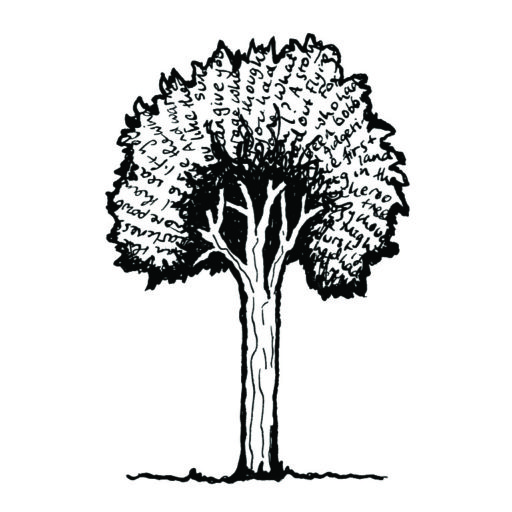
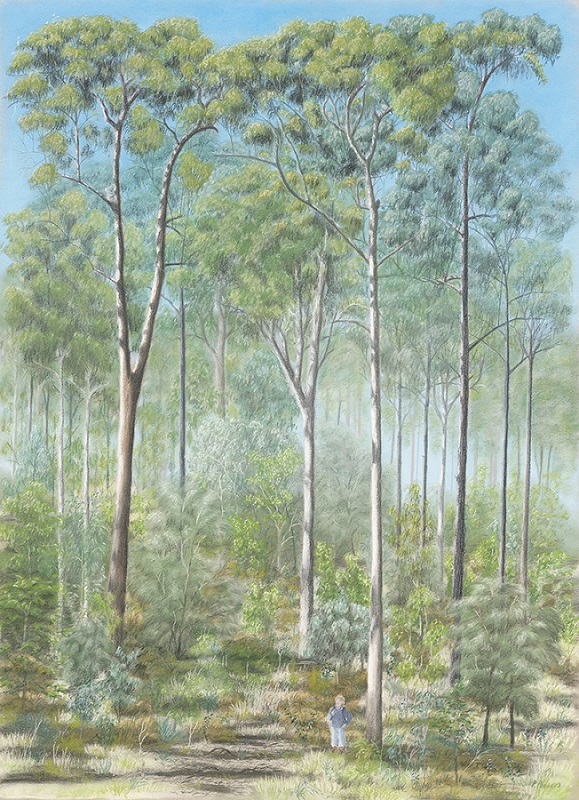
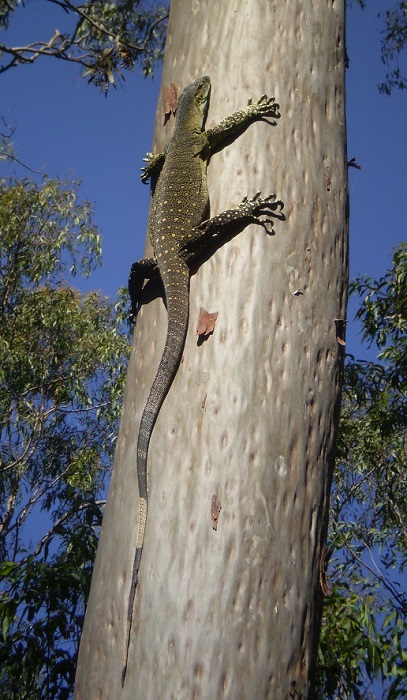
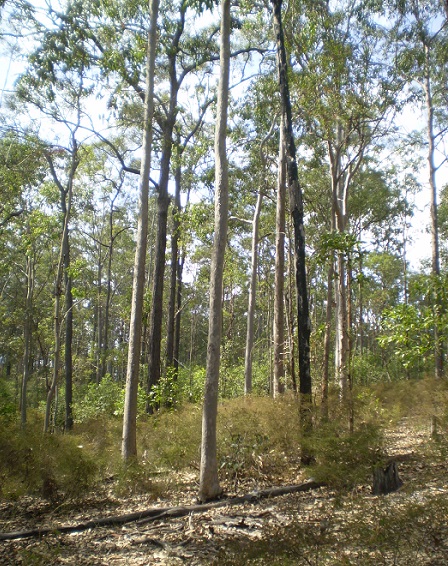
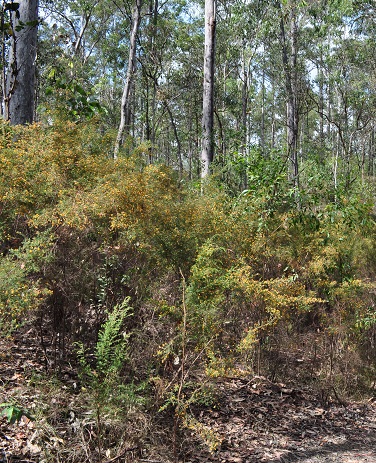
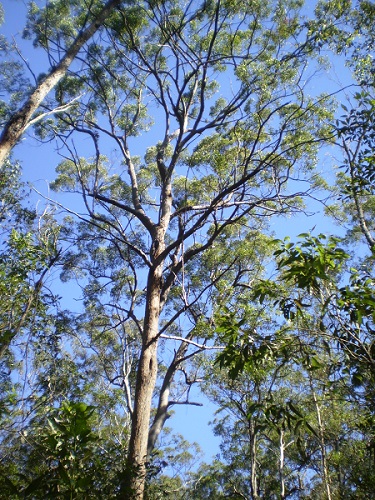


Your painting gave me a lovely sense of calm, as I imagined myself there in the forest.
Ahh that’s great. Thanks Paula, glad you enjoyed it.
I love this painting, having spent alot of time in these forests, I can definitley say you’ve captured the spirit of this community 🙂 Well done Paula!
Thank you Annie. Your praise means a lot to me, particularly since you know these forests, and their plants and animals, so well.
Hi Paula,
Your forest looks so full of light! And it’s reasonably green for a dry sclerophyll forest. Sometimes they’re all grey, brown and rust colours – next to no understorey at all.
I really like your casuarinas; you’ve captured them beautifully.
Another fabulous painting 🙂
Glad you like it Dayna. Yes I find the forests up here do seem very green sometimes, especially since I’ve spent a lot of time in the southern Australian dry sclero forests, which tend to have far more ‘drier’, subdued colours. At least some of that bright green comes from the brush box saplings (Lophostemon confertus). I find this species in nearly every forest I visit in south east Queensland – it’s a remarkable tree. Thank you for your comments about the sheoaks – they are one of my favorites.
Now I’m intrigued. Not ‘Where’s Wally?’ But where is the crested hawk? Thanks for an interesting post and a lovely pastel. It could be me standing there.
Apologies Robyn! The crested hawk is in the top right corner of the picture, in the upper branches of the spotted gum that Ray is standing directly underneath. But you will need to use your imagination a bit, since it’s hard to distinguish at this resolution of the picture. But I’m thrilled you were intrigued!
Hi Paula,
I’ve mentioned this before but your artwork would be beautiful in nature books for children. My son was given a book with pictures of a similar style that had lots of creatures hidden in the scenes for children to discover. Thank you also for educating me in the identification of our native trees and the kind of forests we have as it’s something I’m sadly lacking knowledge about.
Best wishes!
Thanks Jane, I’d love to do a children’s book – we must talk more about this one day . It’s a pleasure raving to you and others about forests – one of my favorite subjects, as I’m sure you’ve guessed by now. Cheers, Paula
You’ve again captured lovely light in this painting. I really enjoy the perspective from halfway up the forest Paula. It’s like a view I’d have as a bird flying by.
Fabulous! Thanks Gail. Glad you survived the writer’s festival too.
Hey Pauls, I especially love how you’ve captured the forest floor with the shadows and tufts and the colours, I really can imagine myself walking around in there as some of your other ‘post-ers’ have said.
Thanks Linda, I’m really pleased that the picture is draws you in like that. 🙂
Hi Paula,
I stumbled across your blog and dug into because I too, am trying to paint an entire forest without decapitating the trees. In fact, I am doing it for a mural in Buderim, based on the school’s famous Pine Forest. These massive trees have been around nearly as long as Buderim. The challenge is scale and how much detail to leave in, what sadly has to be left out. I want to see the horizontal lines in the bark and the gorgeous moss and lichen,…. but if I keep the tops of these tall pines in, then what gets lost?
I think I am early in the muddling tea-drinking process. I’ve still got a few days of priming / prep-work before I have to decide.
I enjoyed reading several pages of your site and I think all of your forest portraits a beautiful. They feel like familiar places to me here in SEQ.
Regards,
Anna.
Hi Anna, I’m excited that you’re also trying to paint a forest, and I’m looking forward to seeing what you come up with. I understand the juggle of tree height versus detail. Maybe you could do one or two araucaria trunks close up, and have other full-height ones in the distance? I haven’t tackled araucarias yet, but plan to in a portrait of dry rainforest I’d like to complete before the year is out.
Thanks for your lovely comments, it means a lot to me that you recognise the portraits as familiar places in SEQ. I’ll be interested to hear what you think of the next one I will blog about – a portrait of the scribbly gum / heathy forest near Beerwah. Cheers, Paula
Lovely painting and I enjoyed reading about your view of the forest and its light. I stumbled across this blog whilst researching how to dry our the bark from the paperbark trees for a craft thing I want to do .
Look forward to follwing you
Adrienne
Hi Adrienne, thanks for dropping by and commenting, I’m glad you enjoyed my post. What crafty thing are you planning for your paperbark?
Cheers
Paula